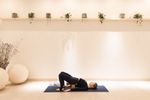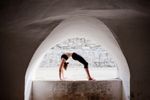Whether you're an experienced yogi or new to the practice, these three moves can promote sounder shuteye.
Practicing yoga in the evening can help you to transition from an active day to a restorative night’s sleep, as you unwind tension from your body and calm your body before going to bed.
Try to focus on taking deep exhales, which can help lower blood pressure, soothe the parasympathetic nervous system, encourage the body’s rest-and-digest state and ease anxiety. Also, concentrate on feeling the touch of your head to the ground and the sensations of relaxation as you move through this simple sequence.
1. Downward-Facing Dog (Variation)
- Start on your hands and knees and place one block long and flat between your wrists. Balance a second block on the back edge of the first block to create a "see-saw." Lastly, place a thin blanket over the blocks so you have a softer landing for your head.
- With your hands shoulder-width distance apart, lift your hips up and back into down dog. You can have your legs bent or straight depending on your flexibility.
- Relax your head onto the blocks. The bottom edge of the block will tilt off the floor as you transfer the weight of your head to the block. (Readjust the height or location of the blocks as needed if your head doesn’t naturally rest on the top block.) Balance weight evenly between your hands, feet and your head.
- Work up to holding this pose for a minute and a half. Let the touch of your head to the block be a physical reminder to quiet your mind, exhale and let go. Observe your breath and see if you can make your exhales twice as long as your inhales.
- When you are done, come to your knees, sit your hips back, and rest your head on the ground in child's pose for another minute or so.
2. Supported Bridge Pose

- Come to lie down on your back with your blocks within reach on the sides of your mat. Bend your knees. Press down into your heels and lift your hips up off the floor.
- Press down into your upper arm bones and shoulders as you lift your chest towards your chin. Allow your chin to relax towards your chest. Feel for one of your blocks with your hands, and place it under your pelvis at any height. Relax your pelvis on the block.
- Balance your weight evenly between your feet, pelvis, shoulders and head as you work toward holding the pose for three minutes. Observe any sensations of relaxation in the body. Continue to emphasize the length of your exhales.
- When you feel ready to exit the pose, press down into your shoulders, lift your hips, remove the block, lower to the ground and relax on the floor for a moment.
3. Shoulder Stand Variation
This variation of shoulder stand requires a similar setup of the blocks that you did in the downdog variation, but this time the support of the props will be under your pelvis instead of under your head. Again, we will be using the bottom block like a see-saw so there can be a balance of support-and-give to the foundation.
- Lie on your back and make sure that your two blocks are reachable. Bend your knees and lift your hips into a bridge pose. Place a block on its lowest height and widest width under your pelvis. The second block on its lowest height and widest width and lay it on the back edge of the first block.
- Set your pelvis down onto the broad, flat surface of the top block so that the bottom edge lifts off the floor. Make sure the blocks feel good and supportive. Adjust them as necessary until you feel like you can relax your weight into your pelvis, shoulders and head evenly.
- Keeping your pelvis on the blocks, lift your feet into the air and angle your legs up and over your torso. Keep your chest broad as you evenly balance your weight between your shoulders, head, and pelvis. Observe your exhales and any sensations of relaxation.
- Work on holding this pose for up to three minutes. When you are ready to come down. bring one foot to the ground at a time. Lift the hips off the block, remove the blocks and lower to rest. Roll to your side, come up to sit, and close your practice in a way that is meaningful to you.




